Yeohelmetguy
Well-known member
It has been several months since I have posted any of the British dragoon helmets in my collection here on the “Forum”. For this post I have opted for something of aa bit of a departure from my usual dragoon helmet posts. As many of the helmet featured on the Pickelhaube Forum are German States infantry helmets I thought it might be appropriate and of interest to the membership that I share the Victorian/Edwardian British infantry equivalent, in this instance a Victorian helmet and associated helmet plates recently added to my collection.
The example in this post is an officers helmet attributed to the Loyal North Lancashire Regiment. Dress Regulation for The Officers of the Army, under the heading of “General Instructions, issued by Horse Guards, War Office on 17 May 1883, give the following specification regarding the helmet, Home Pattern:
(a) Cork, covered with blue cloth in four seams, two on each side; peaks front and back, stiffened and covered with cloth without seam; the front peak bound with gilt medal 3/16 inch wide, the back with patent leather 1/8 inch wide. Above the peaks and going around the helmet a cloth band ¾ inch wide and stitched top and bottom. Back peat to center of crown 10 1/2 inches; front peak to center of crown 10 1/4 inches; side to center of crown 8 inches. Gilt curb chin chain strap, the links 5/8 inch wide and the strap lined with black velvet. Gilt rose fastenings at the sides; gilt convex bar ¼ inch wide down the center of the back and to the bottom of the back peak. The bar is in one piece and is fastened to the helmet by means of two studs and a flattened prolongation of the bar under the back peak. At the top of the helmet, a spike mounted on a cross-piece base.
The dimensions of the spike are- Height of the spike from the place of insertion in the top of the rose of the cross-piece base 2¾ inches. Total height of spike base 3 ¼ inches. Diameter of spike at point of contact with top of rose base 7/8 inch.
The cross-piece base is of gilt metal; there is a rose at the top into which the spike is screwed, and a smaller rose on each of the four terminations of the base. A gilt hook at the back of the base, to which the chin strap is attached when not required to be worn under the chin. The width of the base from the point of the front termination to the point of the rear termination, measured in a straight line underneath 4 and 3/8 inches, that from side to side 3 ½ inches. The base is attached to the helmet by four screws and nuts. For ventilation, the base is perforated with four holes. A gilt collet is inserted in the crown of the helmet.
(b) In the Field Batteries and Garrison Brigades of the Royal Artillery, a gilt ball in a leaf cup is substituted for the spike. Height of ball and cup, 1¾ inches.
(c) In Light Infantry, the helmet is covered with dark green cloth.
(d) In Rifle regiments the helmet is covered with rifle-green cloth, and bronze is substituted for gilt metal in the fittings. Bronze curb-chain chin strap on Morocco leather of the color of regimental facings. The leather lined with black velvet.
For details of general pattern helmet plates, we find the following in Dress Regulations:
In gilt metal, a star surmounted by a Crown; on the star a laurel wreath; within the wreath a garter inscribed, “Honi soit qui mal y pense”; within the garter the badge approved for the territorial regiments. On the bottom of the wreath, a silver scroll with the designation of the regiment. The dimensions of the plate are- from top of the crown to the bottom of the plate, back measurement, 5 inches; extreme horizontal width, back measurement, 41/2 inches; the bottom central ray of the plate comes halfway over the band of the helmet.
It should be noted, in each regiments volunteer battalions, all of the items described as “gilt” in the description of the helmet and helmet plate above are depicted in silver/silver plate.
The helmet depicted herein is attributed to an officer of the Loyal North Lancashire Regiment as described in and conforming to the 1883 uniform regulations and as worn from 1881 through 1901. Also shown (picture #2) is an officer’s helmet plate as worn by officers of the regiments 1st Volunteer Battalion during the same period. Additionally, an example of (picture #3) an officer’s helmet plate to the 3rd Regiment Duke of Lancasters Own (Militia) as worn from 1878 to 1881 when the regiment became the 3rd Volunteer Battalion, Loyal North Lancashire Regiment and adopted a plate like that shown at picture two with the additional scroll below the regimental tile scroll inscribed “3rd Volunteer Battalion” all in silver.
Additionally, officers, be they in regular army battalions/regiments or volunteer battalion/regimental officers, were required to procure/purchase their own uniforms and accoutrements through a variety of private military tailors and suppliers so there is some minor variation to be seen especially in accoutrements though always generally conforming to sealed patterns.
The Loyal Regiment (North Lancashire) was, until 1921, known as the Loyal North Lancashire Regiment was a line infantry regiment of the British Army. It was in existence from 1881 to 1970. In 1970, the regiment was amalgamated with the Lancashire Regiment to form the Queen’s Lancashire Regiment which was, in 2006, amalgamated with the King’s Own Border Regiment and the King’s Regiment (Liverpool and Manchester) to form the Duke of Lancaster Regiment (King’s, Lancaster and Border).
The Loyal North Lancashire Regiment was formed as part of the Childers Reforms of 1881 by the amalgamation of the 47th (Lancashire) Regiment of Foot, 81st Regiment of Foot (Loyal Lincoln Volunteers), 3rd Royal Lancashire Militia (Duke of Lancaster’s Own) and the 11th and 14th Lancashire Rifle Volunteer Corps’. The Loyals were one of seven county regiments recruiting in Lancashire. The depot was at Preston, and the regimental district also included the towns of Bolton, Chorley, Farnworth, Hindley, and the Isle of Man. As part of the Cardwell Reforms, the 47th and 81st regiments were linked. The depot for the linked regiment was Fulwood Barracks at Preston. Beginning in 1873, the regiments which would eventually be re-designated as the Loyal North Lancashire Regiment were brigaded together and began moving their depots to Fulwood, however, it would not be until 1877 that the moves were completed when the required facilities were completed.
The barracks themselves had been completed in 1848 and served as the station for a number of units between 1848 and 1881. Notably, in the 1860s, it was occupied by the 11th Depot Battalion, which served as depot unit for the 11th Hussars and of the 1st/10th, 2nd/10th, 1st/11th, 32nd, 41st and 55th Regiments of Foot. In 1861, Pte Patrick McCaffery, a 19-year-old private soldier with the 32nd (Cornwall) Regiment of Foot shot and killed the Depot's commander, Colonel Hugh Crofton, and Depot's adjutant, Captain John Hanham, with a single shot. The incident began over McCaffery's punishment for failing to vigorously pursue an investigation into some children who had broken some windows at the barracks. McCaffery was tried and convicted at the Liverpool Assizes. He was executed on 11 January 1862. It is claimed that, since that time, his ghost haunts the officer's mess at Fulwood barracks.
In 1899, the Loyal North Lancashire Regiment found itself in South Africa. With hostilities seeming likely in the aftermath of the Jameson Raid, the De Beers company became increasingly concerned with the security of its operations in Kimberly. Although a town guard and other volunteer formations had been raised, the De Beers company and citizens of Kimberly petitioned for additional security measures. On 7 October 1899, an artillery battery and four companies of the Loyal North Lancashire Regiment were dispatched to secure the town under the command of Lieutenant-Colonel Robert Kekewich.. Five days later, with the start of hostilities, Boer forces arrived and began to besiege Kimberly. For the next 126 days, the Loyal North Lancashire Regiment and the local militias would be cut off and subjected to regular shelling from Boer artillery. The siege was finally lifted when Brigadier-General Sir John French’s Cavalry Division was able to break through the Boer lines on 15 February 1900.
With its commander and four of its companies under siege in Kimberly, the balance of the 1st Battalion, Loyal North Lancashire Regiment served with Lord Methuen. Together with the 1st Battalion, Northumberland Fusiliers, 2nd Battalion, Northamptonshire Regiment, and 2nd Battalion, King’s Own (Yorkshire Light Infantry), formed the 9th Brigade of the 1st Division. They served with 9th Brigade at the Battles of Belmont, Modder River and Magersfotien.
Following the relief of Kimberly in February 1900, the reunited battalion would remain part of Methuen's command until July, when it was detached to guard Oliphant's Nek. On 8 August, the battalion was relieved of this task at the orders of Colonel Baden-Powell and left the area unguarded. This allowed Christiaan De Witt to escape the British forces attempting to catch him. Although the Boer escaped, it was ruled that orders received by the Loyal North Lancashire Regiment were to blame, and the regiment escaped censure.
The end of 1900 found 1st Battalion, Loyal North Lancashire Regiment back with the 9th Brigade. As part of the brigade, they took part in actions around Klerksdorp. Remaining under Lord Methuen's command for the rest of the war, the Loyals provided men to be formed into mounted infantry companies as the war shifted from large engagements into a guerilla war. The Loyals would continue to serve throughout the guerrilla phase, engaging Boer commandos on a number of occasions until the end of the war with the signing of the Treaty of Vereeniging on 31 May 1902. Following the end of hostilities, 525 officers and men of the battalion left Cape Town in the SS Carisbrook Castle in September 1902, arriving at Southampton early the following month.
The 3rd Battalion was among the first militia units to be embodied for full-time duty, on 13 December 1899, and went to Kent for pre-deployment training at Shorncliffe and Lydd. It then embarked on 12 January 1900 and sailed to Malta to relieve a regular army battalion in the garrison there. A year later the manpower needs of the guerrilla war in South Africa led to the battalion re-embarking from Malta on 2 March 1901. It arrived in South Africa on 30 March and was employed on the lines of communication from Port Elizabeth to Aliwal North, a town in the East Cape. The battalion embarked for home on 13 February 1902 and was disembodied on 15 March.
The 2nd Battalion had been stationed in the United Kingdom after the amalgamation in 1881, serving in England to 1887, at Jersey in 1887-1890, in Ireland 1890-1896, and again in England until 1899. From 1899 there were postings in the Mediterranean, at Malta until 1901, followed by a year at Crete and from May 1902 at Gibraltar In 1908, the Volunteers and Militia were reorganized nationally, with the former becoming the Territorial Force and the latter the Special Reserve the regiment now had one Reserve and two Territorial battalions.
At the onset of the First World War the Loyal North Lancashire Regiment raised a number of extra war service battalions. In all the Loyal North Lancashire Regiment expanded to 21 infantry battalions for service at home and abroad. Of these, there were the two regular battalions (the 1st and 2nd Battalions), the Special Reserve (former militia) battalion (3rd Reserve Battalion), ten Territorial Battalions (1/4th, 1/5th, 2/4th, 2/5th, 3/4th, 3/5th, 4/5th 1/12th (Pioneers), 2/12th and 14th Battalions), and seven service battalions of Kitchener’s Army (6th, 7th, 8th, 9th, 10th, 11th (Reserve) and 15th Battalions), as well as a home service battalion (13th (Home Service) Battalion).
The 1/4th Battalion landed at Boulogne as part of the 154th Brigade in the 51st (Highland) Division in May 1915 for service on the Western Front. The 1/5th Battalion landed at Le Havre as part of the 16th Brigade in the 6th Division in February 1915 also for service on the Western Front. The 2/4th Battalion landed at Le Havre as part of the 170th Brigade in the 57th (2nd West Lancashire) Division in February 1917 also for service on the Western Front. The 2/5th Battalion landed at Le Havre as part of the 154th Brigade in the 51st (Highland) Division in February 1917 also for service on the Western Front. The 4/5th Battalion landed at Le Havre as part of the 170th Brigade in the 57th (2nd West Lancashire) Division in February 1917 also for service on the Western Front. The 1/12th Battalion (Pioneers) landed at Le Havre as pioneer battalion to the 60th (2nd London) Division in June 1916 also for service on the Western Front.
The 6th (Service) Battalion sailed as part of the 38th Brigade of the 13th (Western) Division to join the Mediterranean Expeditionary Force and landed at Anzac Cove on 4 August 1915. After participating in the battles at Anzac Cove and Suvla Bay, the battalion, along with the rest of the division, was withdrawn from Gallipoli and sent to Egypt to refit in January 1916. In February 1916, the division was ordered to move to join the Tigris Corps in its operations to relieve the Anglo-Indian garrison besieged at Kut. As part of the Tigris Corps, the battalion attempted to lift the Siege of Kut. Initially deployed along the left bank of the Tigris River, the battalion participated in the Battle of Fallahiya on 6 April 1916 and Battle of Sanniyah on 9 April 1916. The battalion managed to break into the Turkish positions at the Sanniyah, but because follow-on forces were unable to link up with them, they along with the rest of the 38th Brigade were eventually driven back. The battalion were next tasked with seizing the beachhead on the far side of the Diyala River. Approximately 100 men of the battalion were able to make the initial crossing on 8 March 1917. Subjected to multiple counterattacks through the day, the battalion held on to the beachhead despite the main force being unable to land more troops. They were not relieved until the next day when the Turkish forces retreated.
The 7th (Service) Battalion landed at Boulogne as part of the 56the Brigade in the 19th (Western) Division in July 1915 for service on the Western Front. The 8th (Service) Battalion and the 9th (Service) Battalion both landed at Boulogne as part of the 74th Brigade in the 25th Division in September 1915 also for service on the Western Front. The 10th (Service) Battalion landed at Boulogne as part of the 112th Brigade in the 37th Division in August 1915 also for service on the Western Front. The 15th (Service) Battalion landed at Boulogne as the pioneer battalion to the 14th (Light) Division in July 1918 also for service on the Western Front.
Even though The Great War ended with the Armistice, battalions of the Loyal Regiment remained active in the early post-war years. The 2nd Loyal North Lancashire Regiment were sent to Ireland for service during the Irish War of Independence. The Loyal North Lancashire Regiment were dispatched to serve during the Chanak Crisis in Turkey in September 1922. Both battalions of the Loyal North Lancashire Regiment served in China during the “Warlord Era” and the Chinese Civil War, protecting the legation in Peking and the international settlements at Tientsin, Canton, and most importantly Shanghai. The 1st Battalion, Loyal North Lancashire Regiment also saw action in policing the British Mandate of Palestine during the 1936-1939 Arab revolt in Palestine.
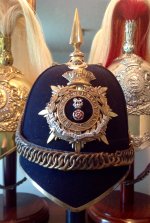
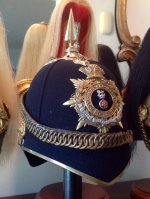
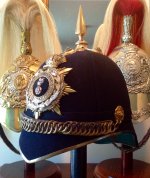
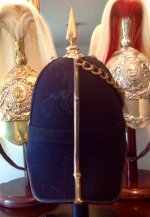
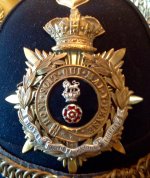
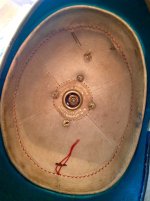
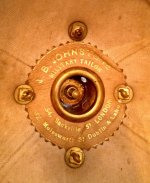
OFFICERS HOME SERVICE HELMET, THE LOYAL NORTH LANCASHIRE REGIMENT WORN 1881 THROUGH 1901
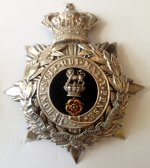
OFFICERS HOME SERVICE HELMET PLATE 1st VOLUNTEER BARRALION, THE LOYAL NORTH LANCASHIRE REGIMENT WORN 1881 THROUGH 1901. (PHOTO #2)
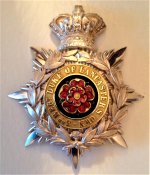
OFFICERS HOME SERVICE HELMET PLATE 3rd REGIMENT DUKE OF LANCASTERS OWN (MILITIA) WORN 1878 THROUGH 1880 WHEN THE REGIMENT BECAME THE 3rd BATTALION, LOYAL NORTH LANCASHIRE REGIMENT. (PHOTO #3)
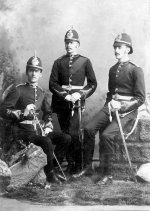
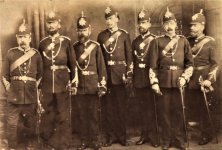
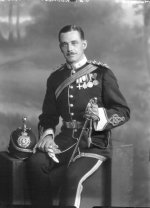
The example in this post is an officers helmet attributed to the Loyal North Lancashire Regiment. Dress Regulation for The Officers of the Army, under the heading of “General Instructions, issued by Horse Guards, War Office on 17 May 1883, give the following specification regarding the helmet, Home Pattern:
(a) Cork, covered with blue cloth in four seams, two on each side; peaks front and back, stiffened and covered with cloth without seam; the front peak bound with gilt medal 3/16 inch wide, the back with patent leather 1/8 inch wide. Above the peaks and going around the helmet a cloth band ¾ inch wide and stitched top and bottom. Back peat to center of crown 10 1/2 inches; front peak to center of crown 10 1/4 inches; side to center of crown 8 inches. Gilt curb chin chain strap, the links 5/8 inch wide and the strap lined with black velvet. Gilt rose fastenings at the sides; gilt convex bar ¼ inch wide down the center of the back and to the bottom of the back peak. The bar is in one piece and is fastened to the helmet by means of two studs and a flattened prolongation of the bar under the back peak. At the top of the helmet, a spike mounted on a cross-piece base.
The dimensions of the spike are- Height of the spike from the place of insertion in the top of the rose of the cross-piece base 2¾ inches. Total height of spike base 3 ¼ inches. Diameter of spike at point of contact with top of rose base 7/8 inch.
The cross-piece base is of gilt metal; there is a rose at the top into which the spike is screwed, and a smaller rose on each of the four terminations of the base. A gilt hook at the back of the base, to which the chin strap is attached when not required to be worn under the chin. The width of the base from the point of the front termination to the point of the rear termination, measured in a straight line underneath 4 and 3/8 inches, that from side to side 3 ½ inches. The base is attached to the helmet by four screws and nuts. For ventilation, the base is perforated with four holes. A gilt collet is inserted in the crown of the helmet.
(b) In the Field Batteries and Garrison Brigades of the Royal Artillery, a gilt ball in a leaf cup is substituted for the spike. Height of ball and cup, 1¾ inches.
(c) In Light Infantry, the helmet is covered with dark green cloth.
(d) In Rifle regiments the helmet is covered with rifle-green cloth, and bronze is substituted for gilt metal in the fittings. Bronze curb-chain chin strap on Morocco leather of the color of regimental facings. The leather lined with black velvet.
For details of general pattern helmet plates, we find the following in Dress Regulations:
In gilt metal, a star surmounted by a Crown; on the star a laurel wreath; within the wreath a garter inscribed, “Honi soit qui mal y pense”; within the garter the badge approved for the territorial regiments. On the bottom of the wreath, a silver scroll with the designation of the regiment. The dimensions of the plate are- from top of the crown to the bottom of the plate, back measurement, 5 inches; extreme horizontal width, back measurement, 41/2 inches; the bottom central ray of the plate comes halfway over the band of the helmet.
It should be noted, in each regiments volunteer battalions, all of the items described as “gilt” in the description of the helmet and helmet plate above are depicted in silver/silver plate.
The helmet depicted herein is attributed to an officer of the Loyal North Lancashire Regiment as described in and conforming to the 1883 uniform regulations and as worn from 1881 through 1901. Also shown (picture #2) is an officer’s helmet plate as worn by officers of the regiments 1st Volunteer Battalion during the same period. Additionally, an example of (picture #3) an officer’s helmet plate to the 3rd Regiment Duke of Lancasters Own (Militia) as worn from 1878 to 1881 when the regiment became the 3rd Volunteer Battalion, Loyal North Lancashire Regiment and adopted a plate like that shown at picture two with the additional scroll below the regimental tile scroll inscribed “3rd Volunteer Battalion” all in silver.
Additionally, officers, be they in regular army battalions/regiments or volunteer battalion/regimental officers, were required to procure/purchase their own uniforms and accoutrements through a variety of private military tailors and suppliers so there is some minor variation to be seen especially in accoutrements though always generally conforming to sealed patterns.
The Loyal Regiment (North Lancashire) was, until 1921, known as the Loyal North Lancashire Regiment was a line infantry regiment of the British Army. It was in existence from 1881 to 1970. In 1970, the regiment was amalgamated with the Lancashire Regiment to form the Queen’s Lancashire Regiment which was, in 2006, amalgamated with the King’s Own Border Regiment and the King’s Regiment (Liverpool and Manchester) to form the Duke of Lancaster Regiment (King’s, Lancaster and Border).
The Loyal North Lancashire Regiment was formed as part of the Childers Reforms of 1881 by the amalgamation of the 47th (Lancashire) Regiment of Foot, 81st Regiment of Foot (Loyal Lincoln Volunteers), 3rd Royal Lancashire Militia (Duke of Lancaster’s Own) and the 11th and 14th Lancashire Rifle Volunteer Corps’. The Loyals were one of seven county regiments recruiting in Lancashire. The depot was at Preston, and the regimental district also included the towns of Bolton, Chorley, Farnworth, Hindley, and the Isle of Man. As part of the Cardwell Reforms, the 47th and 81st regiments were linked. The depot for the linked regiment was Fulwood Barracks at Preston. Beginning in 1873, the regiments which would eventually be re-designated as the Loyal North Lancashire Regiment were brigaded together and began moving their depots to Fulwood, however, it would not be until 1877 that the moves were completed when the required facilities were completed.
The barracks themselves had been completed in 1848 and served as the station for a number of units between 1848 and 1881. Notably, in the 1860s, it was occupied by the 11th Depot Battalion, which served as depot unit for the 11th Hussars and of the 1st/10th, 2nd/10th, 1st/11th, 32nd, 41st and 55th Regiments of Foot. In 1861, Pte Patrick McCaffery, a 19-year-old private soldier with the 32nd (Cornwall) Regiment of Foot shot and killed the Depot's commander, Colonel Hugh Crofton, and Depot's adjutant, Captain John Hanham, with a single shot. The incident began over McCaffery's punishment for failing to vigorously pursue an investigation into some children who had broken some windows at the barracks. McCaffery was tried and convicted at the Liverpool Assizes. He was executed on 11 January 1862. It is claimed that, since that time, his ghost haunts the officer's mess at Fulwood barracks.
In 1899, the Loyal North Lancashire Regiment found itself in South Africa. With hostilities seeming likely in the aftermath of the Jameson Raid, the De Beers company became increasingly concerned with the security of its operations in Kimberly. Although a town guard and other volunteer formations had been raised, the De Beers company and citizens of Kimberly petitioned for additional security measures. On 7 October 1899, an artillery battery and four companies of the Loyal North Lancashire Regiment were dispatched to secure the town under the command of Lieutenant-Colonel Robert Kekewich.. Five days later, with the start of hostilities, Boer forces arrived and began to besiege Kimberly. For the next 126 days, the Loyal North Lancashire Regiment and the local militias would be cut off and subjected to regular shelling from Boer artillery. The siege was finally lifted when Brigadier-General Sir John French’s Cavalry Division was able to break through the Boer lines on 15 February 1900.
With its commander and four of its companies under siege in Kimberly, the balance of the 1st Battalion, Loyal North Lancashire Regiment served with Lord Methuen. Together with the 1st Battalion, Northumberland Fusiliers, 2nd Battalion, Northamptonshire Regiment, and 2nd Battalion, King’s Own (Yorkshire Light Infantry), formed the 9th Brigade of the 1st Division. They served with 9th Brigade at the Battles of Belmont, Modder River and Magersfotien.
Following the relief of Kimberly in February 1900, the reunited battalion would remain part of Methuen's command until July, when it was detached to guard Oliphant's Nek. On 8 August, the battalion was relieved of this task at the orders of Colonel Baden-Powell and left the area unguarded. This allowed Christiaan De Witt to escape the British forces attempting to catch him. Although the Boer escaped, it was ruled that orders received by the Loyal North Lancashire Regiment were to blame, and the regiment escaped censure.
The end of 1900 found 1st Battalion, Loyal North Lancashire Regiment back with the 9th Brigade. As part of the brigade, they took part in actions around Klerksdorp. Remaining under Lord Methuen's command for the rest of the war, the Loyals provided men to be formed into mounted infantry companies as the war shifted from large engagements into a guerilla war. The Loyals would continue to serve throughout the guerrilla phase, engaging Boer commandos on a number of occasions until the end of the war with the signing of the Treaty of Vereeniging on 31 May 1902. Following the end of hostilities, 525 officers and men of the battalion left Cape Town in the SS Carisbrook Castle in September 1902, arriving at Southampton early the following month.
The 3rd Battalion was among the first militia units to be embodied for full-time duty, on 13 December 1899, and went to Kent for pre-deployment training at Shorncliffe and Lydd. It then embarked on 12 January 1900 and sailed to Malta to relieve a regular army battalion in the garrison there. A year later the manpower needs of the guerrilla war in South Africa led to the battalion re-embarking from Malta on 2 March 1901. It arrived in South Africa on 30 March and was employed on the lines of communication from Port Elizabeth to Aliwal North, a town in the East Cape. The battalion embarked for home on 13 February 1902 and was disembodied on 15 March.
The 2nd Battalion had been stationed in the United Kingdom after the amalgamation in 1881, serving in England to 1887, at Jersey in 1887-1890, in Ireland 1890-1896, and again in England until 1899. From 1899 there were postings in the Mediterranean, at Malta until 1901, followed by a year at Crete and from May 1902 at Gibraltar In 1908, the Volunteers and Militia were reorganized nationally, with the former becoming the Territorial Force and the latter the Special Reserve the regiment now had one Reserve and two Territorial battalions.
At the onset of the First World War the Loyal North Lancashire Regiment raised a number of extra war service battalions. In all the Loyal North Lancashire Regiment expanded to 21 infantry battalions for service at home and abroad. Of these, there were the two regular battalions (the 1st and 2nd Battalions), the Special Reserve (former militia) battalion (3rd Reserve Battalion), ten Territorial Battalions (1/4th, 1/5th, 2/4th, 2/5th, 3/4th, 3/5th, 4/5th 1/12th (Pioneers), 2/12th and 14th Battalions), and seven service battalions of Kitchener’s Army (6th, 7th, 8th, 9th, 10th, 11th (Reserve) and 15th Battalions), as well as a home service battalion (13th (Home Service) Battalion).
The 1/4th Battalion landed at Boulogne as part of the 154th Brigade in the 51st (Highland) Division in May 1915 for service on the Western Front. The 1/5th Battalion landed at Le Havre as part of the 16th Brigade in the 6th Division in February 1915 also for service on the Western Front. The 2/4th Battalion landed at Le Havre as part of the 170th Brigade in the 57th (2nd West Lancashire) Division in February 1917 also for service on the Western Front. The 2/5th Battalion landed at Le Havre as part of the 154th Brigade in the 51st (Highland) Division in February 1917 also for service on the Western Front. The 4/5th Battalion landed at Le Havre as part of the 170th Brigade in the 57th (2nd West Lancashire) Division in February 1917 also for service on the Western Front. The 1/12th Battalion (Pioneers) landed at Le Havre as pioneer battalion to the 60th (2nd London) Division in June 1916 also for service on the Western Front.
The 6th (Service) Battalion sailed as part of the 38th Brigade of the 13th (Western) Division to join the Mediterranean Expeditionary Force and landed at Anzac Cove on 4 August 1915. After participating in the battles at Anzac Cove and Suvla Bay, the battalion, along with the rest of the division, was withdrawn from Gallipoli and sent to Egypt to refit in January 1916. In February 1916, the division was ordered to move to join the Tigris Corps in its operations to relieve the Anglo-Indian garrison besieged at Kut. As part of the Tigris Corps, the battalion attempted to lift the Siege of Kut. Initially deployed along the left bank of the Tigris River, the battalion participated in the Battle of Fallahiya on 6 April 1916 and Battle of Sanniyah on 9 April 1916. The battalion managed to break into the Turkish positions at the Sanniyah, but because follow-on forces were unable to link up with them, they along with the rest of the 38th Brigade were eventually driven back. The battalion were next tasked with seizing the beachhead on the far side of the Diyala River. Approximately 100 men of the battalion were able to make the initial crossing on 8 March 1917. Subjected to multiple counterattacks through the day, the battalion held on to the beachhead despite the main force being unable to land more troops. They were not relieved until the next day when the Turkish forces retreated.
The 7th (Service) Battalion landed at Boulogne as part of the 56the Brigade in the 19th (Western) Division in July 1915 for service on the Western Front. The 8th (Service) Battalion and the 9th (Service) Battalion both landed at Boulogne as part of the 74th Brigade in the 25th Division in September 1915 also for service on the Western Front. The 10th (Service) Battalion landed at Boulogne as part of the 112th Brigade in the 37th Division in August 1915 also for service on the Western Front. The 15th (Service) Battalion landed at Boulogne as the pioneer battalion to the 14th (Light) Division in July 1918 also for service on the Western Front.
Even though The Great War ended with the Armistice, battalions of the Loyal Regiment remained active in the early post-war years. The 2nd Loyal North Lancashire Regiment were sent to Ireland for service during the Irish War of Independence. The Loyal North Lancashire Regiment were dispatched to serve during the Chanak Crisis in Turkey in September 1922. Both battalions of the Loyal North Lancashire Regiment served in China during the “Warlord Era” and the Chinese Civil War, protecting the legation in Peking and the international settlements at Tientsin, Canton, and most importantly Shanghai. The 1st Battalion, Loyal North Lancashire Regiment also saw action in policing the British Mandate of Palestine during the 1936-1939 Arab revolt in Palestine.







OFFICERS HOME SERVICE HELMET, THE LOYAL NORTH LANCASHIRE REGIMENT WORN 1881 THROUGH 1901

OFFICERS HOME SERVICE HELMET PLATE 1st VOLUNTEER BARRALION, THE LOYAL NORTH LANCASHIRE REGIMENT WORN 1881 THROUGH 1901. (PHOTO #2)

OFFICERS HOME SERVICE HELMET PLATE 3rd REGIMENT DUKE OF LANCASTERS OWN (MILITIA) WORN 1878 THROUGH 1880 WHEN THE REGIMENT BECAME THE 3rd BATTALION, LOYAL NORTH LANCASHIRE REGIMENT. (PHOTO #3)



Last edited:
